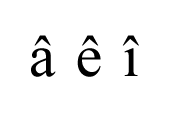Circumflex
Appearance

The circumflex ( ˆ ) is a diacritic mark used in written French, Esperanto, Norwegian, Romanian, Vietnamese,Japanese, Welsh, Portuguese, and other languages.
- In French the circumflex is used on the vowels â, ê, î, ô, and û. It is largely redundant. It marks the former presence of the letter s in the spelling of the word. For example, hôpital (hospital), forêt (forest). However, in the case of ô, it changes the value of the vowel: cote and côte are not homonyms (the former means "level", "mark", the latter means "coast").
- In Esperanto, it is used on ĉ, ĝ, ĥ, ĵ, and ŝ. It indicates a completely different consonant from the unaccented form, and is considered a separate letter for purposes of collation. See Esperanto orthography.
- In Norwegian, it is used, with the exception of loan words, on ô and ê, almost exclusively in the words "fôr" (from Norse fóðr), meaning "animal food", lêr, meaning "skin" (Norse leðr) and "vêr" (Norse veðr), meaning "weather".
- In English, the circumflex is sometimes used on loanwords; for example, rôle.
- In Romanian, the circumflex is used on the vowels â and î to mark a sound similar to Russian 'yery'.
- In Vietnamese, the circumflex helps to distinguish three couples of vowels : ô [o] and o [ɔ], ê [e] and e [ɛ], â [ɐ] and a [ɑ]. It is not a tonal mark, so that you can for instance find association of circumflex and tonal mark, like ệ, which appears in the word Việt Nam
- In Kunrei-shiki romanized Japanese, the circumflex marks long vowels. It is also occasionally used as a surrogate for the macron for marking long vowels in the Hepburn system.
- In Welsh the circumflex (to bach) is used in single-syllable words to show the difference between other words that have the same spelling. The circumflex in Welsh makes a vowel a long vowel (môr/mor).
- In Portuguese, it is used on â, ê and ô. It mainly marks the tonic syllable, but sometimes it is used to distinguish homophone words, e.g. tem (he has) and têm (they have).
Using the ISO-8859-1 character encoding, one can type the letters â, ê, î, ô, and û. Dozens more letters with the circumflex are available in Unicode. Unicode also provides the circumflex as a combining character.
The circumflex receives its English name from the Latin circumflexus (bent about).
